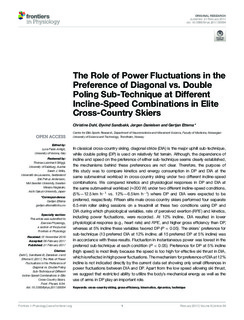| dc.contributor.author | Dahl, Christine | |
| dc.contributor.author | Sandbakk, Øyvind | |
| dc.contributor.author | Danielsen, Jørgen | |
| dc.contributor.author | Ettema, Gertjan | |
| dc.date.accessioned | 2017-12-02T07:37:26Z | |
| dc.date.available | 2017-12-02T07:37:26Z | |
| dc.date.created | 2017-10-19T14:00:14Z | |
| dc.date.issued | 2017 | |
| dc.identifier.issn | 1664-042X | |
| dc.identifier.uri | http://hdl.handle.net/11250/2468812 | |
| dc.description.abstract | In classical cross-country skiing, diagonal stride (DIA) is the major uphill sub-technique, while double poling (DP) is used on relatively flat terrain. Although, the dependence of incline and speed on the preference of either sub-technique seems clearly established, the mechanisms behind these preferences are not clear. Therefore, the purpose of this study was to compare kinetics and energy consumption in DP and DIA at the same submaximal workload in cross-country skiing under two different incline-speed combinations. We compared kinetics and physiological responses in DP and DIA at the same submaximal workload (≈200 W) under two different incline-speed conditions, (5%—12.5 km h−1 vs. 12%—6.5 km h−1) where DP and DIA were expected to be preferred, respectively. Fifteen elite male cross-country skiers performed four separate 6.5-min roller skiing sessions on a treadmill at these two conditions using DP and DIA during which physiological variables, rate of perceived exertion (RPE) and kinetics, including power fluctuations, were recorded. At 12% incline, DIA resulted in lower physiological response (e.g., heart rate) and RPE, and higher gross efficiency than DP, whereas at 5% incline these variables favored DP (P < 0.05). The skiers' preference for sub-technique (13 preferred DIA at 12% incline; all 15 preferred DP at 5% incline) was in accordance with these results. Fluctuation in instantaneous power was lowest in the preferred sub-technique at each condition (P < 0.05). Preference for DP at 5% incline (high speed) is most likely because the speed is too high for effective ski thrust in DIA, which is reflected in high power fluctuations. The mechanism for preference of DIA at 12% incline is not indicated directly by the current data set showing only small differences in power fluctuations between DIA and DP. Apart from the low speed allowing ski thrust, we suggest that restricted ability to utilize the body's mechanical energy as well as the use of arms in DP play an important role. | nb_NO |
| dc.language.iso | eng | nb_NO |
| dc.publisher | Frontiers Media | nb_NO |
| dc.rights | Navngivelse 4.0 Internasjonal | * |
| dc.rights.uri | http://creativecommons.org/licenses/by/4.0/deed.no | * |
| dc.title | The role of power fluctuations in the preference of diagonal vs. double poling sub-technique at different incline-speed combinations in elite cross-country skiers | nb_NO |
| dc.type | Journal article | nb_NO |
| dc.type | Peer reviewed | nb_NO |
| dc.description.version | publishedVersion | nb_NO |
| dc.source.volume | 8 | nb_NO |
| dc.source.journal | Frontiers in Physiology | nb_NO |
| dc.identifier.doi | 10.3389/fphys.2017.00094 | |
| dc.identifier.cristin | 1505961 | |
| dc.description.localcode | © 2017 Dahl, Sandbakk, Danielsen and Ettema. This is an open-access article distributed under the terms of the Creative Commons Attribution License (CC BY). The use, distribution or reproduction in other forums is permitted, provided the original author(s) or licensor are credited and that the original publication in this journal is cited, in accordance with accepted academic practice. No use, distribution or reproduction is permitted which does not comply with these terms. | nb_NO |
| cristin.unitcode | 194,65,30,0 | |
| cristin.unitname | Institutt for nevromedisin og bevegelsesvitenskap | |
| cristin.ispublished | true | |
| cristin.fulltext | original | |
| cristin.qualitycode | 1 | |

